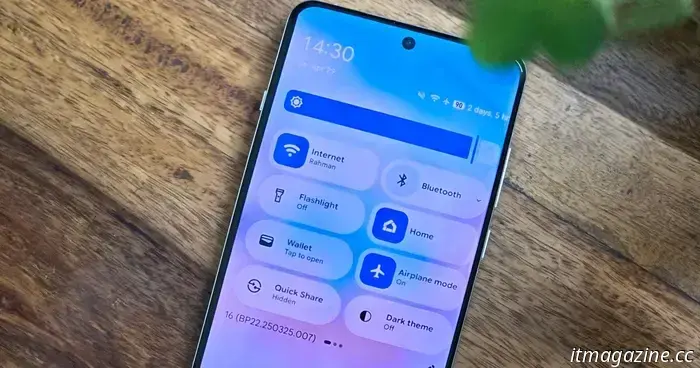
This Android redesign looks fantastic, but I only wish it had arrived earlier.
Each year, Google introduces numerous features to Android. However, changes to its visual design happen only every few years. The last major visual update was with Android 12 over three years ago. In the months to come, Google is anticipated to begin another round of aesthetic enhancements, with notable modifications across the UI, just before the official release of Android 16. This has generated heightened expectations, but it may arrive too late.
The redesigned Android interface brings a refreshing change, featuring vibrant colors and entirely updated sliders throughout the system. Even the smaller elements, like icons in the status bar, are being refined, emerging with more detail than in previous versions. Many components of the interface appear to have adopted a translucent style, lending a more contemporary feel. While the visual improvements are striking, the timing seems peculiar.
Google’s forthcoming Android version, Android 16, is imminent and is expected to be formally unveiled at Google I/O, the annual developers' conference set for May 20th. The immediate thought is that Google might unveil this new feature alongside other significant updates for Android later this month, but there are indicators that suggest otherwise.
To begin with, these modifications have not been seen as a widely accessible feature. Instead, they were discovered by the Android Authority team in the latest Android 16 beta, who reverse-engineered the code to activate the new interface. This means that most users, including those testing the Android 16 beta on Pixel devices, will not have access to the new features yet. But does this imply these features will be available when Android 16 is finally released as a stable update to a broader user base? That remains uncertain.
The timing of this preview appears poorly planned
Every significant visual or feature overhaul typically coincides with a new Android version. Major upgrades warrant dedicated version number updates, and any lesser treatment would not be adequate. This trend holds true for other software companies as well—Apple is anticipated to refresh its interface across iOS, macOS, and tvOS with a consistent, glass-inspired theme.
Moreover, it is common practice for software companies to preview interface changes well in advance as part of beta previews. This does not only help consumers acclimate to radical updates that may require them to adjust how they navigate the interface, but it also provides time to incorporate user feedback into the design.
Google adheres to a similar approach with many features, where changes are presented as optional capabilities rather than being forced onto users. A pertinent example is Adaptive icons, which have been part of Android since version 12, yet have not reached a level of functionality—let alone perfection.
Due to these factors, it appears less likely that Google will include these changes in Android 16. Instead, it is more probable that they will lay the groundwork for a major visual update in Android 17.
Additionally, another reason supporting this assumption is that Google had fewer months to develop Android 16, having initiated its developer preview program in October of the previous year. Typically, this process occurs in February, with Google I/O being the stage where potential features are showcased for the final release. However, this year, Google seems to be pushing things forward—after a delay in the launch of Android 15 last year, Android 16 is already nearing completion.
Consequently, it would not be prudent for Google to release features with minimal testing and virtually no feedback from developers or users. A more likely scenario is that these features will be announced later in the year as exclusive to the Pixel 10 series, even though Google has not previously differentiated devices based on visual elements, which could complicate the open nature of Android.
The uncertainty continues
While it seems improbable for Google to make such a leap so soon, certain factors may lead them to defy our expectations. For one, Google is developing a third iteration of its Material Design theming engine, with "Expressive" reportedly being the guiding principle behind this update.
Android Authority mentions that Google plans to introduce this concept to developers at the I/O conference, aiming to encourage them to incorporate these visual elements into their applications. In contrast to Apple, which enforces strict standards for iOS app appearances, Google takes a more relaxed approach. This might mean that developers could take some time to adopt these changes across upcoming Android versions.
Nonetheless, for elements Google can manage, such as the Settings menu, Quick Settings, or notifications, it may release the new interface sooner as an optional theme. Whether this will occur at the upcoming Google I/O, with the Pixel 10 launch in the latter half of 2025, or alongside the Android 17 beta remains entirely uncertain.
The redesign is long overdue
Regardless of how Google presents the rollout, the proposed interface looks appealing and desirable. I find myself wishing that Google hadn't delayed its introduction for so long. Compared to other Android manufacturers, the opaque sections in stock Android feel drab and uncomfortable. By adopting this redesign, Android would be catching up to iOS, as well as other brands





Other articles
 Today, Kim Kardashian Beats Studio Pro headphones are available at a 50% discount.
The Kim Kardashian Dune edition of the Beats Studio Pro are available for $170 on Amazon. This is significant, as these over-ear headphones typically retail for $350.
Today, Kim Kardashian Beats Studio Pro headphones are available at a 50% discount.
The Kim Kardashian Dune edition of the Beats Studio Pro are available for $170 on Amazon. This is significant, as these over-ear headphones typically retail for $350.
 Hollow Knight: Silksong is currently playable, but a release date has not yet been announced.
Hollow Knight: Silksong will be available to play in the Game Worlds exhibit in Melbourne, Australia.
Hollow Knight: Silksong is currently playable, but a release date has not yet been announced.
Hollow Knight: Silksong will be available to play in the Game Worlds exhibit in Melbourne, Australia.
 If you aren't currently using Google to scan documents, this update makes it essential.
If you aren't currently using Google for scanning documents, this update makes it essential.
If you aren't currently using Google to scan documents, this update makes it essential.
If you aren't currently using Google for scanning documents, this update makes it essential.
 James Webb directs its attention towards the coldest exoplanet ever identified.
The James Webb Space Telescope has studied a frigid planet orbiting a type of dead star known as a white dwarf.
James Webb directs its attention towards the coldest exoplanet ever identified.
The James Webb Space Telescope has studied a frigid planet orbiting a type of dead star known as a white dwarf.
 One of our preferred handheld gaming PCs is now available at a discounted price — the Lenovo Legion Go for $600.
The Lenovo Legion Go portable gaming PC comes with an 8.8-inch display, an AMD Ryzen Z1 Extreme chip, and a 512GB SSD, priced at $600.
One of our preferred handheld gaming PCs is now available at a discounted price — the Lenovo Legion Go for $600.
The Lenovo Legion Go portable gaming PC comes with an 8.8-inch display, an AMD Ryzen Z1 Extreme chip, and a 512GB SSD, priced at $600.
 This new iPhone update might help you save money in various areas.
latest iPhone
This new iPhone update might help you save money in various areas.
latest iPhone
This Android redesign looks fantastic, but I only wish it had arrived earlier.
Android is undergoing a significant redesign, but the anticipation leading up to it may test your patience.
